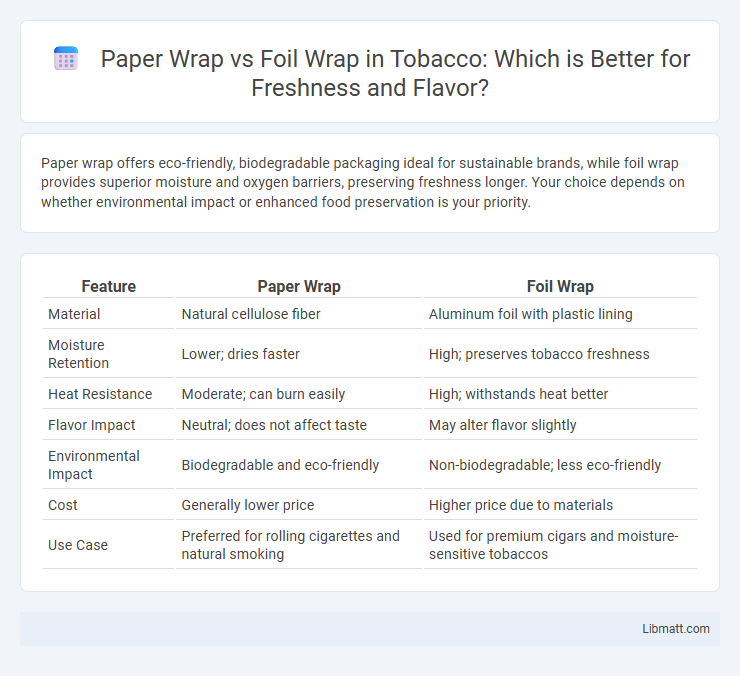Paper wrap offers eco-friendly, biodegradable packaging ideal for sustainable brands, while foil wrap provides superior moisture and oxygen barriers, preserving freshness longer. Your choice depends on whether environmental impact or enhanced food preservation is your priority.
Table of Comparison
| Feature | Paper Wrap | Foil Wrap |
|---|---|---|
| Material | Natural cellulose fiber | Aluminum foil with plastic lining |
| Moisture Retention | Lower; dries faster | High; preserves tobacco freshness |
| Heat Resistance | Moderate; can burn easily | High; withstands heat better |
| Flavor Impact | Neutral; does not affect taste | May alter flavor slightly |
| Environmental Impact | Biodegradable and eco-friendly | Non-biodegradable; less eco-friendly |
| Cost | Generally lower price | Higher price due to materials |
| Use Case | Preferred for rolling cigarettes and natural smoking | Used for premium cigars and moisture-sensitive tobaccos |
Introduction to Paper Wrap and Foil Wrap
Paper wrap offers a biodegradable and eco-friendly option for packaging, commonly used for wrapping food items and gifts due to its breathability and ease of printing. Foil wrap provides superior barrier properties against moisture, light, and oxygen, making it ideal for preserving the freshness and flavor of perishable goods. Understanding the characteristics of paper wrap and foil wrap can help you choose the best packaging solution tailored to your product's needs.
Material Composition and Manufacturing
Paper wrap is primarily composed of cellulose fibers derived from wood pulp, making it biodegradable and suitable for sustainable packaging solutions. Foil wrap consists of thin sheets of aluminum produced through rolling and annealing processes, offering superior barrier properties against moisture, light, and air. Manufacturing paper wrap involves pulping, pressing, and drying, whereas foil wrap requires precise metalworking techniques to achieve the necessary thinness and flexibility for food and product preservation.
Environmental Impact: Paper vs Foil
Paper wrap offers a more eco-friendly choice compared to foil wrap due to its biodegradability and ease of recycling, significantly reducing landfill waste. Foil wrap, made from aluminum, requires intensive mining and energy consumption while posing challenges in recycling when combined with food residues. Choosing paper wrap supports sustainable practices by minimizing environmental impact and conserving natural resources without compromising your packaging needs.
Cost Comparison: Which is More Economical?
Paper wrap typically costs less than foil wrap due to lower material and manufacturing expenses, making it a more economical choice for budget-conscious packaging. Foil wrap, while more expensive, offers superior barrier protection against moisture, oxygen, and light, which can reduce product spoilage and waste. Your decision should balance upfront cost savings with long-term preservation benefits, depending on the specific packaging needs.
Insulation and Heat Retention Capabilities
Paper wrap provides moderate insulation and retains heat effectively for short durations, making it suitable for warm food items that require brief heat preservation. Foil wrap offers superior insulation due to its reflective surface, which minimizes heat loss by reflecting thermal radiation and creating a tight seal to trap steam and moisture. For long-term heat retention, foil wrap outperforms paper wrap by maintaining higher temperatures and preventing heat diffusion, essential for transporting hot meals.
Food Safety and Preservation
Paper wrap offers breathable protection that helps prevent moisture buildup, making it ideal for short-term food storage and maintaining freshness without trapping heat. Foil wrap provides a strong barrier against light, oxygen, and bacteria, ensuring superior food safety and longer preservation by preventing spoilage and contamination. Choosing foil wrap for your food can extend shelf life, while paper wrap is better suited for items needing ventilation.
Reusability and Recycling Options
Paper wrap offers superior recyclability and is often accepted in curbside recycling programs, making it an eco-friendly choice for single-use packaging. Foil wrap can be reused several times if kept clean but poses recycling challenges due to its aluminum content and contamination risks. You can optimize sustainability efforts by choosing paper wrap for easy recycling and reserving foil wrap for multi-use applications.
Practical Applications: When to Use Each Wrap
Paper wrap is ideal for packaging dry, lightweight items like sandwiches, baked goods, and takeaway foods due to its breathability and eco-friendliness. Foil wrap excels in preserving heat, moisture, and freshness, making it suitable for wrapping hot foods, leftovers, and items requiring longer shelf life. Selecting between paper wrap and foil wrap depends on the food's temperature, moisture content, and desired preservation duration to maintain quality and functionality.
Consumer Preferences and Market Trends
Consumer preferences indicate a growing demand for sustainable packaging solutions, with paper wrap gaining popularity due to its biodegradability and eco-friendly appeal. Market trends reveal that foil wrap remains favored for its superior barrier properties and preservation capabilities, especially in food packaging sectors. Brands are increasingly adopting hybrid packaging that combines paper's environmental benefits with foil's protective features to meet diverse consumer expectations.
Final Verdict: Choosing the Right Wrap
Paper wrap offers eco-friendly benefits with biodegradability and breathability, making it ideal for wrapping sandwiches and fresh produce. Foil wrap provides superior heat retention and airtight sealing, perfect for preserving cooked meals and preventing moisture loss. Selecting the right wrap depends on prioritizing sustainability and freshness with paper or durability and temperature control with foil.
Paper wrap vs foil wrap Infographic

 libmatt.com
libmatt.com